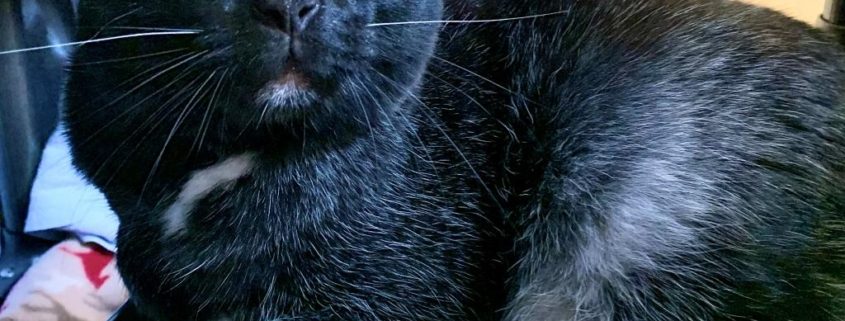Ask Crystal: Hidden Cat

I have taken 2 of my mom’s cats into my home when she went to assisted living. One is settling in…. it’s been 3 months. The other hides and is using our pantry area as a litter box. How can I get this to stop? I can’t find him…. only seen brief glimpses of him.
Sincerely,
Hidden Kitty
Dear Hidden,
That sounds like a really difficult situation. I am sure your mom really appreciates your help with her kitties. Cats just like people have different personalities and some adapt to change better than others. There may be some fundamental behaviors that are not going to change but hopefully you can get the kitty feeling a little better about the situation.
One of the most stressful situations that can happen to a cat is a move. It’s not uncommon for a cat to respond as prey by running and hiding. In addition to the move, he is not with his usual person. Cats are naturally inclined to believe that a new person in their environment is a threat.
It would be tremendously helpful to have more information about how the cat interacted at your mom’s house to know what the cat will be most comfortable with as far as interaction from humans and living arrangements.
Socialization is how comfortable a cat is around humans. A cat may be well socialized, less socialized, unsocialized or fully unsocialized. The easiest way to tell the difference is what is called the Touch Barrier. The difference between socialized and unsocialized cats is whether they will let a person touch them. The Touch Barrier is attributed to cat expert Joan Miller.
We also want to consider the cat’s comfort zone. This is how close a cat can live or spend time with people and stay comfortable. These cats may be considered indoor only, indoor/outdoor, people adjacent or outskirts. Check out www.alleycats.org to find out where your mom’s cat falls.
This should help you to understand what circumstance the cat is going to feel most comfortable in. Unfortunately, often we cannot take a cat from a very different living situation and expect them to be ok in a new situation. This especially applies for fully unsocialized cats. Socialization is what helps animals adapt to new situations. The fact that he is still hiding from you after 3 months would lead me to believe he is unsocialized.
- Create a safe room for the kitty in a quiet, small room. Having too much room is overwhelming for fearful cats, they do better when given a small amount of space. In the room, provide everything the cat will need such as food, water, litterboxes and bedding. Offer clothing that smells like you so he can get used to your smell. This is the first step for a cat accepting someone into their family group.
- Try to keep the environment as quiet as possible initially. While it is impossible to avoid all noise, it will help if you keep starting noises in the house down. You may want to have a white noise machine or classical music playing in the cat room.
- Pheromones such as Feliway can be helpful with reducing a cat’s stress levels. You can use a plug-in diffuser or spray it on a blanket. This can help reduce his stress levels which will make him easier to work with.
- Offer hiding places such as a box on its side with a blanket over it. Block hiding spots that you don’t want the cat to use just as behind appliances. This will also help with not being able to find him. Cats should also be offered high up places so that they can watch from above safely. Keep the door to the room closed.
- Work on creating a positive association with food. Several times a day come into the room and place a small amount of canned food near the cat in his hiding spot. Sit as far away as possible while he eats. You may also toss a couple treats his way and move away. Use the best treats you can think of. Think tuna, eggs, deli meat, etc. for very high value.
Cats respond much better to people that play hard to get. In the beginning, you may need to avoid speaking to him and just sit in the room quietly. Sit on the ground so that you are less threatening to the kitty. Turn sideways to the cat and look away. We want to let him make the choice to approach. Repeat this at least 3 times daily for 10 minutes.
You can work your way up to softly speaking to the cat. Avoid loud noises or fast movements. If he comes near you, you can slowly offer a finger to sniff. If he rubs on the finger, you can slowly try to rub under his chin. If he moves away, let him. Never try to chase after him or pick him up. We won’t get anywhere by forcing things. Cats gain confidence by being able to make choices. Choosing whether to be seen. It is their choice if they interact with you or not.
We often find that a scared cat will open up if we try to engage in playing with them. Sit on the floor and set a toy near you. Let him sniff the toy. If he seems interested, slowly pick up the toy and pet his face with it. You can also try to gently pet him with your hand. For the first few sessions, this is probably all you will do. As he gets used to it, start to playing slowly and occasionally use the toy to pet him and sometimes your hand and then go back to playing.
Genetics can play a large role in behavior as well. Many animals will lean towards fearful and unless someone is actively working towards socializing them, they will be more fearful. You can get different expressions of genetics within litters as well. Some of the litter will be more confident naturally than others.
He might be using your pantry as a litter box because it feels safe to him. Cats can be very particular about where they use the litter box. Again, asking your mom where he used to use the litter box would be helpful. He probably needs boxes in places that are quiet, in a corner without having his exits blocked. You also need at least three litterboxes. One for each cat plus one extra box.
Cats are also very particular about what type of litter they like to use and what type of boxes he prefers. Again, knowing what he is used to would be helpful, so you can make sure you are providing what he prefers. Cats prefer a routine so try to do things at the same time daily for him so they can know what to expect. This helps to ease the stress and anxiety.
It is important to be very patient in this situation. He is likely always going to be a fearful cat to some degree and that is something that you just have to accept. You will likely be able to get him to a point where he will approach you for feeding. He may or may not let you touch him. I commend you for wanting to provide the best life you can for him. It may end up being a different life than you would pick for him but every cat has different needs and is an individual. Good luck!
Until next time,
Crystal
Submit your own pet behavior question for Crystal here:







